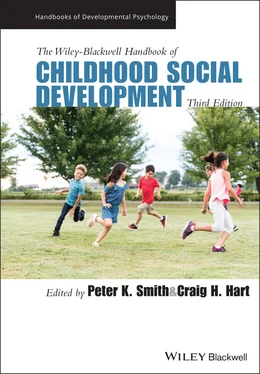Bullying and peer victimization
Research on bullying and peer victimization began in Scandinavia during the late 1970s following a spate of suicides attributed to bullying (Olweus, 1978). By the late 1990s, bullying had become a worldwide public health crisis fueled by a series of highly publicized suicides (Greene, 1993) and violent acts (e.g., 1999 Columbine shootings) committed by previously bullied children. In response to this crisis, scientists from many countries established research and policy initiatives (European Association of Developmental Psychology, 2007 UNESCO, n.d.) and searched for ways to eliminate bullying. Thereafter, evidence began to accrue about the determinants of bullying, the characteristics of bullies and victims, the effects of bullying on victims, the impact of cultures and cohorts, and the results of prevention programs.
Theory and research on the causes of bullying implicated genetic as well as environmental determinants (Ball et al., 2008). Definitional, measurement, and taxonomic innovations led to the identification of different types of bullies (e.g., bullies, bully‐victims), victims (e.g., passive, aggressive victims), and bystanders (e.g., defenders, reinforcers, assistants; Huitsing & Veenstra, 2012). Characteristics ascribed to bullies included aggressiveness, impulsiveness, physical strength, positive self‐concept, and, depending on the subtype, social intelligence (Pabian & Vandebosch, 2016). Passive victims were characterized as shy, anxious, physically weak, isolated, low in self‐esteem, and submissive toward bullies (Olweus, 1978; Perry et al., 1988). In contrast, aggressive, or provocative victims were described as angry, impulsive, emotionally dysregulated, and vengeful (Schwartz, 2000).
The victims of bullying, it was found, often developed multiple and enduring psychological and health problems including internalizing and externalizing problems (Reijntjes et al., 2010, 2011). Many of these maladies were found to be chronic, even following the termination of abuse (Kochenderfer‐Ladd & Wardrop, 2001; Wolke & Lereya, 2015).
Bullying venues and tactics were found to vary by culture and cohort. International surveys (Elgar et al., 2009), although complicated by cultural, definitional, and translational issues (Smith et al., 2016), revealed cross‐national differences in bullying rates (e.g., lower in wealthier countries) and tactics (e.g., harassing familiar vs. unfamiliar peers). As recent cohorts of children accessed cell phones and the internet (Livingstone & Haddon, 2009), bullying venues and tactics shifted, and incidents of “cyberbullying” increased (Wolak et al., 2006). By the mid‐2000s, cyberbullying was a top research priority, and accruing evidence linked it with both internalizing and externalizing problems (Menesini & Spiel, 2012).
Antibullying programs were initially implemented in Scandinavia (Olweus Bully Prevention Program [OBPP]; Olweus & Limber, 2010) and were designed to reduce bullying via adult‐mediated environmental management (e.g., rules, limit setting, establishing consequences). Findings showed that, after 20 months, the OBPP achieved a nearly 50% reduction in bully‐victim problems. Newer programs (e.g., KiVa; Salmivalli & Poskiparta, 2012) incorporated peer‐mediated intervention strategies (e.g., empowering peer defenders) and proved effective particularly with preadolescents. Currently, antibullying efforts are widespread. Investigators in many countries have devised and tested a myriad of antibullying programs, and meta‐analyses of the results suggest that many produce modest but significant reductions in bullying and victimization (Jiménez‐Barbero et al., 2016).
Ethnic and political violence
Although ethnic and political violence likely has harmed children for centuries, the scope, prominence, and severity of contemporary hostilities (e.g., racially motivated genocide, refugee crises, Intifada, repression‐driven internal displacements, World Trade Center bombing) brought this issue to the fore. From the mid‐1980s to the mid‐1990s, it was estimated that approximately 10 million children have been traumatized by war, 1.5 million children have died in armed conflicts, and an additional 4 million have been disabled, maimed, blinded, or suffered brain damage (Benjamin, 1994). Today, it is estimated that approximately 250 million children reside in politically volatile, conflict‐ridden locales (Dubow et al., 2019).
The scientists who studied ethnic and political violence found that the consequences of growing up amid violence, chaos, and deprivation were frequently harmful and often severe. Evidence gathered in many of the world’s trouble spots (e.g., Bosnia, Iraq, Lebanon Palestine, Rwanda; Dubow et al., 2009; Ladd & Cairns, 1996), consistently showed that children exposed to violence exhibited dysfunctions (e.g., PTSD) and often developed enduring adjustment problems (i.e., internalizing and externalizing problems; Dubow et al., 2009, 2019). Given the current level of political tensions, ethnic strife, and terrorist activity throughout the world, this issue will undoubtedly remain a pressing sociocultural concern for the foreseeable future.
Advances in research methodology and analytic strategies
Knowledge about social development expanded at an unprecedented rate during modern and near‐contemporary eras and this accomplishment largely was attributable to changes in scientific practice. Two progressive research innovations were particularly influential: (a) the recruitment and utilization of larger and more diverse samples, and (2) the implementation of enhanced longitudinal research designs and data analytic strategies.
The pursuit of larger samples was motivated by many factors including the challenge of improving sample representativeness and generalizability and the need to obtain larger n s for complex, multivariate analyses. Evidence of this trend was apparent in the progression of studies that were published on social development from the 1970s to the present.
Gains in sample sizes were accompanied by a movement toward sample diversification. Whereas Caucasian samples predominated in published studies during the early decades of this era, this convention eventually was supplanted by ongoing efforts to increase sample representativeness, validate findings in understudied populations, and ensure that underrepresented groups or strata (e.g., minorities, girls and women, low‐income families) were included in scientific research.
Research methods, designs, and analyses
As implied by the term “development,” the principal aim of empirical research on social development has been to account for change (e.g., describe, predict; ultimately “explain” when, how, or why growth occurs) in child characteristics that are conceived as “social.” Near the inception of this era, investigators commonly made inferences about developmental changes from data obtained with cross‐sectional designs (comparing children of different ages concurrently). Longitudinal studies were less prevalent, relatively narrow in scope (e.g., limited to a few focal variables), and often implemented with follow‐back or follow‐up designs. Even rarer were prospective or follow‐through longitudinal studies in which targeted constructs were progressively tracked (i.e., repeatedly measured) across many months or years.
Advances in developmental theory and multivariate statistics expedited a transition toward longitudinal research and increased the utilization of prospective and cross‐sequential longitudinal designs (Baltes, 1968, 1987). The emergence of developmental process models encouraged researchers to devise and implement multiwave, multivariate longitudinal studies in which assessment intervals were sequenced to capture the intervening processes (e.g., variable associations, interactions, transactions) that were hypothesized to drive developmental change.
Читать дальше












